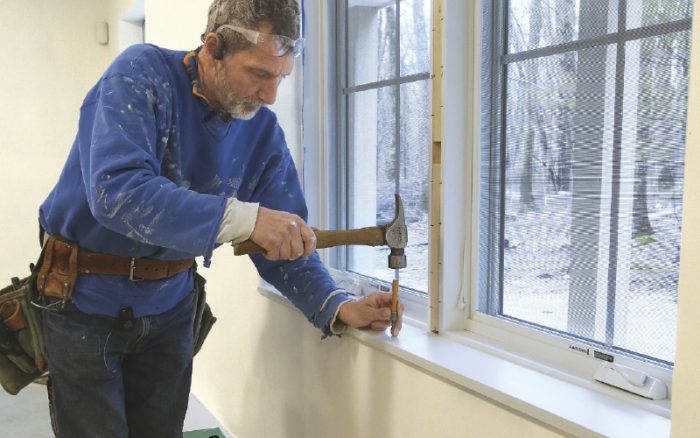Modern Window Stools
For a clean look, skip the casing and install a low-profile stool.

A lot of modern designers eliminate traditional window casings in favor of the clean look that comes from simply returning the drywall to the window. While drywall is fine on the sides and top, the stool (the inside shelf of the sill) needs to be a more durable material. Here, I’m using painted MDF that overhangs the drywall by only about 1⁄2 in., and extends about 1 in. past each side of the window opening. This is a style decision — you could easily overhang the stool farther for more of a nod to traditional design.
Measure
Work from the center. Use site-made pinch sticks to get an accurate measurement of the opening between the jambs, marking the window center on the strips.
Mark the horns. Cut the stool 2 in. longer than the opening to allow for the stool extensions, or “horns”. Align the aluminum strips’ center with the center of the stock, and mark where the horns begin.
Get the angle right. Drywall returns rarely meet the window at 90°. Use a sliding T-bevel (also called a bevel gauge) to duplicate the actual angle.
Transfer the angle. Use the T-bevel to mark this angle on the corresponding stool end. It’s helpful to work on a sawhorse or bench near the window, with the stool oriented as it will be set into the opening.
Find the depth. Measure from the window frame to the corner of the drywall. Check each side — the depths will sometimes differ.
Scribe the face cut. Mark the depths taken from the window on the T-bevel lines, then use a square to mark where the horns will meet the wall.
Cut
Cut to the line. Angle a miter saw to match the T-bevel line, then make a stopped cut up to the line where the horns will meet the face of the wall. Use a Japanese pull saw to finish the miter-saw cut and to make the rip cuts for the horns.
Fit
Sand for clearance. Properly cut, the stool will fit tightly. To avoid gouging the drywall, ease one bottom corner with sandpaper. Set the other end first, then drop the eased end into place.
Fasten and fill. Nail in two 2-in. finish nails every 16 in. or so. A bead of painter’s caulk takes care of any small gaps below the stool.
For more photos and details, click the View PDF button below:


























